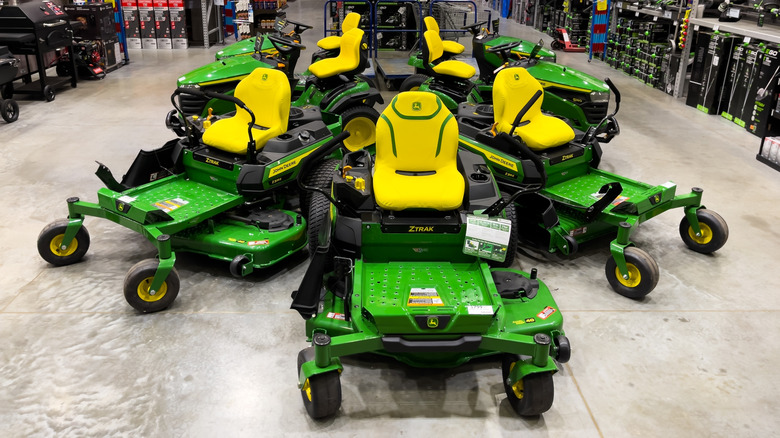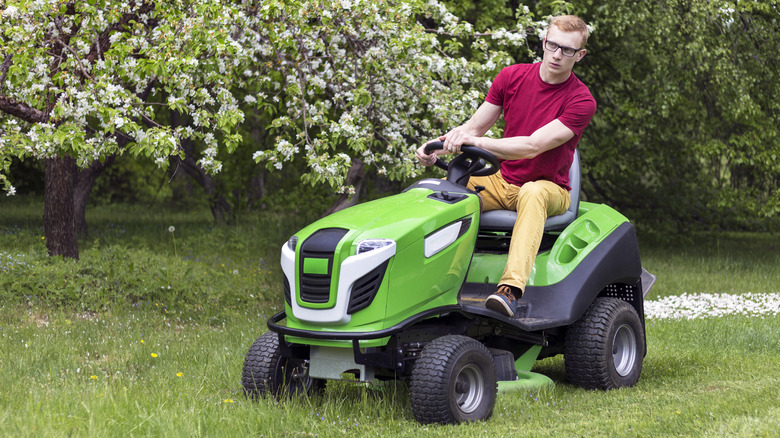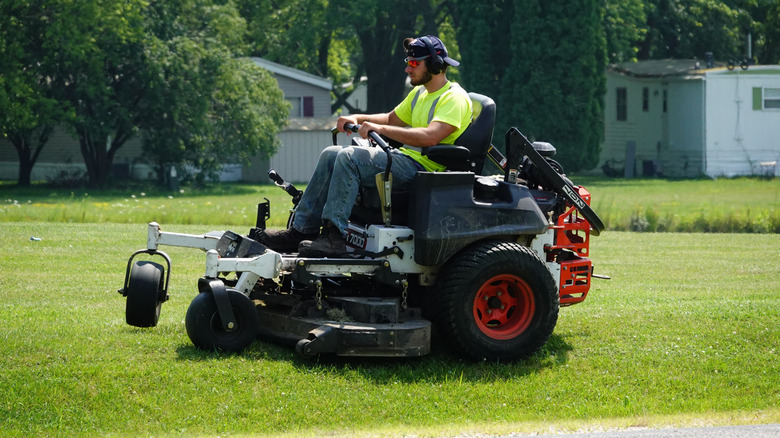Zero Turn Vs. Riding Mower: What's The Difference?
If you have a lawn on the larger side, the idea of a lawn mower that you can sit and ride around on rather than manually pushing is naturally appealing. It saves you energy, it gets the job done faster, and it's a generally more precise way to cut grass than pushing blades around yourself. Before you run out and buy the first mower that catches your eye, though, it's important to clarify that not all rideable mowers are exactly the same.
The concept of a lawn mower that you sit on breaks down further into two distinct varieties, traditional riding mowers and zero turn mowers. Both of these do the same basic thing, cut grass while you sit on it, but there are a few small, yet noteworthy differences that make one kind of mower better than the other for certain situations.
If you're only taking care of your own lawn, and that lawn isn't too huge, a riding mower would be the smarter and more economical option. However, if you've got a much larger lawn on your hands, and especially if you're handling it as a professional lawn care worker, you might want to consider investing in a zero turn mower and the extra speed and precision that comes with it.
Riding mowers are better for personal lawn care
If the only lawn you're looking to mow is your own, and that lawn is small to mid-sized, a traditional riding mower would suit your needs just fine. Riding mowers use the setup you probably think of when you think of a mower you sit on — it's got a traditional seat, a steering wheel, and a small mower blade mounted to the bottom. This simple configuration makes a riding mower easy and comfortable to operate, good for trimming the grass on an afternoon.
Compared to zero turn mowers, however, riding mowers aren't quite as high-spec. They're a little harder to make sharp turns on, and they generally don't move as quickly. This is why they're better for personal lawns rather than professional jobs. A riding mower will get it done, yes, but it'll get it done slowly. On the bright side, riding mowers do have a greater degree of modularity than zero turn mowers, with offshoots like lawn tractors possessing hitches for additional tools like carts or snow throwers. Traditional riding mowers are also a bit cheaper than zero turn mowers — you could realistically get a good riding mower for between $1,500 and $4,000, while a decent zero turn mower can run you well over $10,000 for a high-end model.
Zero turn mowers are better for professional lawn maintenance
If traditional riding mowers are intended for private lawn care, zero turn mowers are their professional-grade siblings. These are the kinds of mowers you've probably seen groundskeepers or road maintenance workers riding on to cut up large swaths of open grass like the sides of a road or a public park. As with a riding mower, there's a seat for the operator, but rather than a wheel, a zero turn mower is controlled with a pair of large side handles.
This particular means of operation gives the operator a much greater degree of control, allowing them to swiftly turn and swivel even at tight angles. They're also generally faster than riding mowers, able to move at speeds of up to 7 mph. The extra horsepower is quite helpful for handling larger yard sizes.
Of course, a zero turn mower is a high-spec piece of equipment, specialized for the exclusive purpose of mowing a lawn. This means you don't get much in the way of modularity or storage space, which can be annoying if you're trying to do more than just cut grass. A zero turn mower's flat-bottom design and smooth tires also cost it a bit in the handling department. They swiftly lose traction on slippery or bumpy terrain, and don't handle inclines very well. A zero turn mower is not a toy for enthusiasts, it's a tool for a professional, with both a price and learning curve to match.


